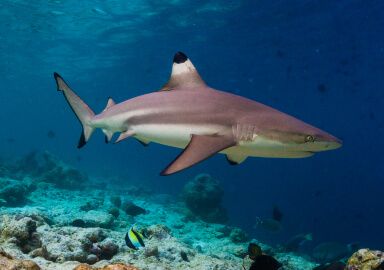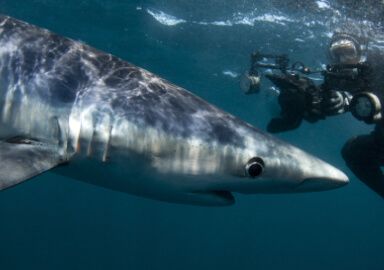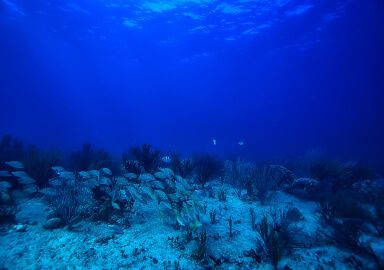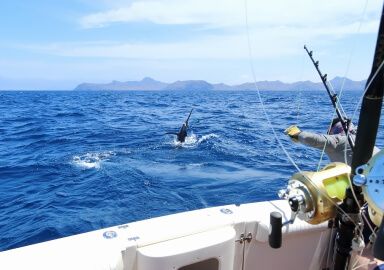Hammerhead Shark
Hammerhead or bonnethead sharks are charismatic, large predators found in most of the world’s warmer oceans and are a prime angling species.
View 8 listings
8
listings
–
price starting from
3
countries
Where and When?
All three of the larger hammerheads are found in the major oceans - including along parts of the eastern and western seaboards of the USA. The greater hammerhead prefers warmer waters and may be caught from North Carolina southwards on the eastern USA shore and Baja California south on the western. The smooth hammerhead prefers cooler waters and may be found southwards from Canadian waters on the eastern seaboard. The scalloped hammerhead is probably the most widely distributed and Florida is a prime hammerhead fishing destination in the USA.
Generally, hammerheads may be found both in the open ocean and close inshore waters and the smooth hammerhead is known to frequent freshwater lagoons and estuaries. Hammerheads feed throughout the day and night, but evenings and mornings are periods of increased activity and fishing should be focussed at these times. It is important to use local knowledge to know when the best time to fish is, as, in some areas, there are general migrations towards warmer waters in winter. In some regions hammerheads also move closer inshore to “pup” at certain times of the year.
About Hammerhead Shark
Of the ten hammerhead sharks, only three - the greater (Sphyrna mokarran), smooth (S. zygaena) and scalloped (S. lewini) - commonly achieve lengths of over two meters (6 ft. 6 in.), and account for most of the angling activity. All hammerheads are generally grey in colour above, gradually blending to white below. All are identifiable by their strangely shaped heads and while some, like the greater hammerhead, have a typical “T shaped” head, others are differently shaped heads but all are broadened with eyes on the extremities.
As a top fish predator they have many fearsome, sharp teeth to catch, hold and bite into prey. The greater hammerhead can attain lengths of over six meters (20 ft.) and 450 kilograms (992 lbs.) at an age of about 30 years. The other two species reach slightly smaller sizes in probably the same time period. Hammerhead sharks undertake extensive migrations and they often shoal during the day and then disperse in the evenings to hunt. Little is known of their mating habits but all produce live young once per year and pup numbers can be from only a few to the 55 found in one massive female greater hammerhead shark caught off Florida in 2006. Female hammerhead sharks are generally larger than males.
Similar Species
Most fishing for hammerheads is carried out from small or charter boats, but shore or pier fishing in suitable areas can also produce good results. Reliable heavy tackle is essential as hammerheads fight strongly and well and often do much of it near the surface. The shark’s teeth are particularly sharp and will easily cut through nylon or braid. Circle hooks are recommended as they often allow easy release of the fish and, in places such as Florida, all hammerheads must be released after capture. Most shark anglers recommend using fairly large, natural baits, particularly fish - either alive or dead. Chumming is used by many anglers to bring sharks to the bait and incite feeding activity. Hammerhead sharks are known as wily adversaries and generally give an excellent and outstanding fight making them an excellent and challenging target for the more experienced anglers.
 Blacktip Shark
19 offers
Blacktip Shark
19 offers
 Blue Shark
8 offers
Blue Shark
8 offers
 Bonnethead Shark
6 offers
Bonnethead Shark
6 offers
 Bull Shark
12 offers
Bull Shark
12 offers
 Great White Shark
1 offer
Great White Shark
1 offer
 Greenland Shark
1 offer
Greenland Shark
1 offer
 Lemon Shark
3 offers
Lemon Shark
3 offers
 Leopard Shark
1 offer
Leopard Shark
1 offer
 Mako Shark
27 offers
Mako Shark
27 offers
 Porbeagle Shark
2 offers
Porbeagle Shark
2 offers
 Shark
128 offers
Shark
128 offers
 Thresher Shark
4 offers
Thresher Shark
4 offers
 Tiger Shark
10 offers
Tiger Shark
10 offers
 Tope Shark
2 offers
Tope Shark
2 offers





